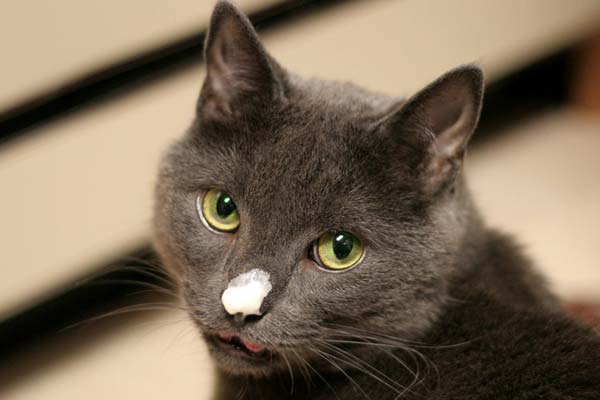Oh, the joy you feel when you see the waiter bringing that hot cocoa with whipped cream. It makes you want to tip them double! Not sure if my cat would be so generous… Can cats eat whipped cream at all?
Whipped cream is a sight for sore eyes, especially for those who love a good swirl! Not to mention the sweet flavor and the way it melts in your mouth. If you have a cat that’s obsessed with whipped cream, that’s a bummer – you can’t eat all of it yourself.
Cats can eat whipped cream, but they really shouldn’t. We know it looks and tastes good, but unfortunately, you’ll have to hide from your furkid when eating whipped cream.
It’s a difficult task to leave her out, especially if your cat’s a grudge-holder and never forgets anything you’ve done to wrong her. No matter how scary your little lap monster might be, don’t give up. Refrain from feeding her whipped cream because it’s for her own good.
Can cats eat whipped cream from time to time?
No matter how popular this topping might be, it doesn’t change the fact that it’s unhealthy for your furbaby. It might be inevitable for your cat to get a hold of it because it can be found in any type of dessert, coffee, pies, etc.
Whipped cream isn’t a natural choice of food for cats. However, it’s natural for cats to be curious about new foods. This can be both adventurous and fun, but dangerous at the same time. Let’s find out the dangers of this treat.
What is whipped cream made of?
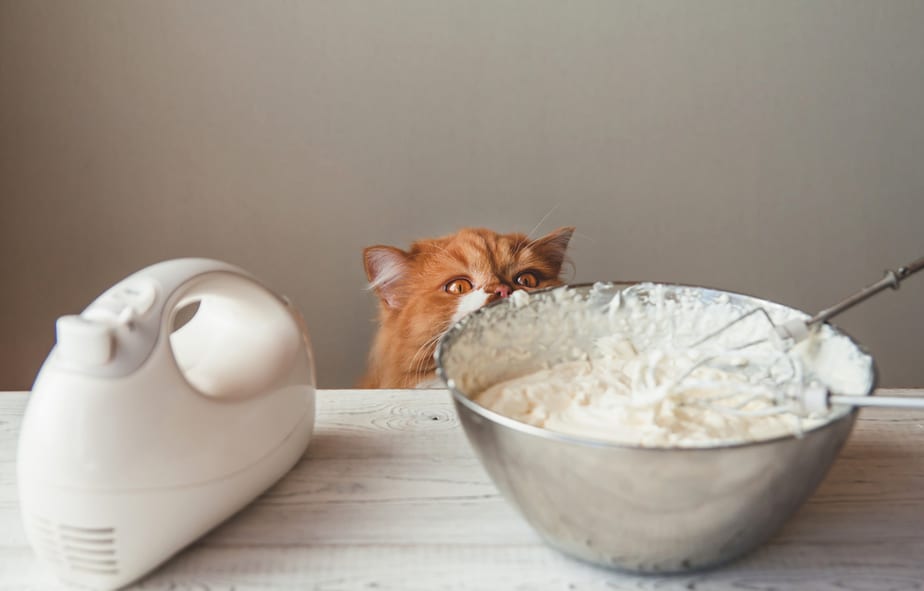
Unfortunately, whipped cream is made of all sorts of things that are harmful to cats. The ingredients used in making this topping can be dangerous for your pet’s intake, ranging from mild to severe symptoms.
Whipped cream is made by whipping heavy cream and adding sugar for the flavor. If you want to spice things up, you could add some chocolate, vanilla, or orange zest. These are all harmful to your feline, so keep an eye out for your mischievous friend.
Can cats eat whipped cream because of dairy?
Cats are actually lactose intolerant. This means they can’t digest the sugar found in milk, heavy cream, etc. Felines lose the enzymes needed for breaking down lactose when they stop breastfeeding.
It’s a common misconception that cats drink milk and eat sour cream, for example. We don’t really know why, but there are lots of movies, ads, and cartoons showcasing our pets lapping up some milk. Maybe it’s just a marketing trick because, as you know, cats are adorable, and they can sell anything!
Nevertheless, now you know the real truth. If you’ve been feeding your pet milk and other dairy products, it’s probably best if you decide against it.
These include vomiting, diarrhea, bloating, abdominal pain, as well as gases. If your pet isn’t showing any signs of gastrointestinal upset, she may tolerate dairy way better than the rest of the cats. However, this doesn’t mean you should continue feeding her milk.
Your furkid is probably more intrigued by the amount of fat found in whipped cream than dairy and sugar.
However, there are other, safer ways for your floof to get this much-needed nutrient. So, even though cats can eat whipped cream in small amounts, they can’t get all the needed nutrients.
What about sugar?

Sugar is harmful to cats in many ways. It’s a simple carbohydrate that doesn’t find its place in a feline’s diet. Cats are carnivores and are wired for eating meat and breaking down protein.
They are unable to digest plant material properly, and therefore, some foods may be left undigested. This could cause trouble in their tummy.
Excessive amounts of sugar are stored as fat because it’s often left unprocessed. A few extra pounds might look harmless, but it could cause larger issues in the long run. Your pet may continue storing these carbs and before you know it, she suffers from obesity.
Being an overweight cat is never easy. Take it from Garfield, he could never enter those cat doors smoothly!
Obesity is an obstacle, but not just in the physical world. Lack of activity is probably the least of your worries when you have an obese cat.
If your pet doesn’t drop a few pounds, she’s at a high risk of numerous health conditions such as heart disease, stroke, diabetes… The list goes on and on, and it’s not one you’d like to read. Besides, you’re putting your feline at risk of losing her teeth!
Tooth decay and other dental problems can develop if she continues to consume sugar. You know this also means bad breath, right?
Chocolate as an addition to whipped cream?
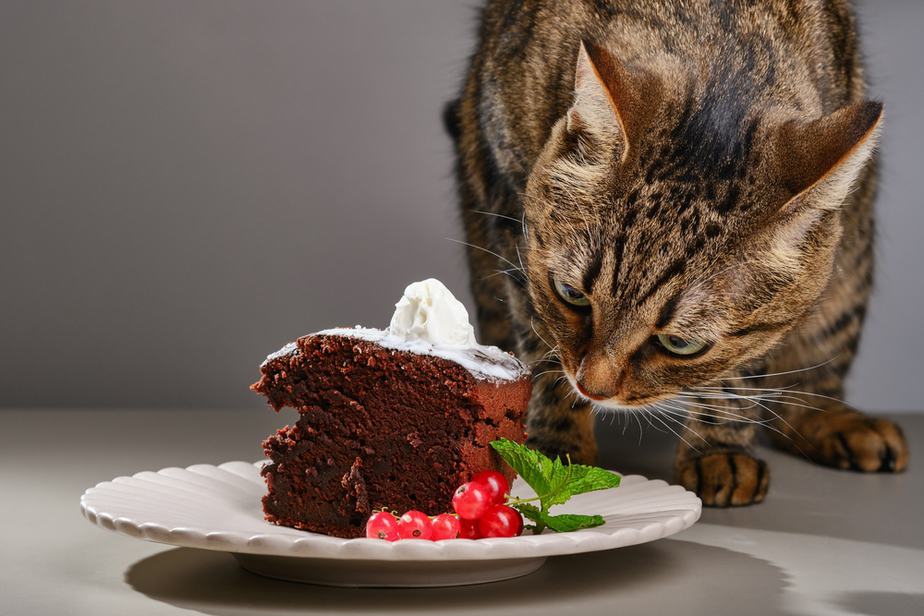
There’s just something special about chocolate. It’s one of the most popular treats all around the world. It’s even more appealing when it’s made in various shapes, sizes, and with different flavors. Chocolate is used as an ingredient in many recipes and whipped cream is no exception.
Chocolate can change the color and texture of whipped cream. Not to talk about that heavenly flavor! Just imagine the taste of chocolate, but soft and foamy from the cream!
There are really just a few people who don’t like chocolate, but what about pets? Can cats eat chocolate whipped cream?
So many questions as a cat parent! Unfortunately, chocolate is another ingredient that makes whipped cream inedible to cats. Not just that, it’s highly poisonous as well. This might sound sad, but don’t be!
Felines can’t taste sweet because they lack the appropriate taste buds. Therefore, they won’t look for sweet foods on their own, and chocolate is definitely not going to make your pet look for some whipped cream. This is a very good thing because of the toxic compounds found within.
Why is chocolate toxic to cats?
Theobromine is a compound found in chocolate and it’s toxic to cats. Your furry friend has a harder time digesting this compound than you. Therefore, it can build up in her stomach and cause poisoning.
Now you’re thinking “Can cats eat whipped cream with milk chocolate or a small amount of chocolate?” The answer is no. Even the smallest amount could be harmful to your pet. Each cat is an individual and you can never fully know how something will affect her. And finding out is definitely not worth the risk!
Chocolate poisoning will manifest itself as gastric distress (vomiting, diarrhea), and abdominal pain. Other, more severe signs, include seizures, tremors, and even coma. In extreme cases, chocolate toxicity may lead to death.
This means no whipped cream with chocolate, no chocolate cake or puddings, or anything related to this dangerous treat! If your pet got a hold of this sweet, it’s best to contact your vet for further treatment.
What about vanilla?
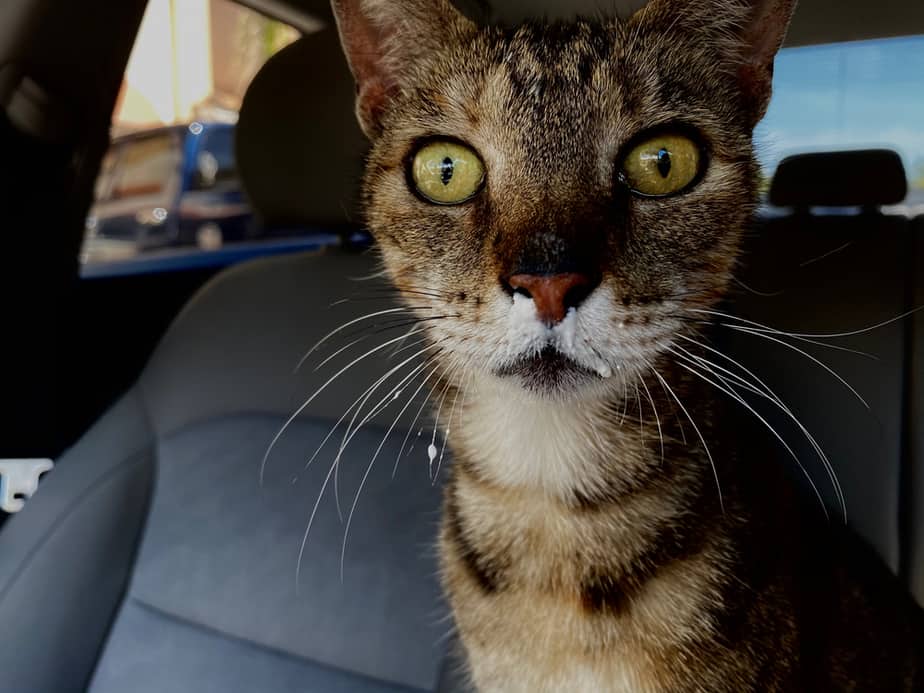
Don’t blame the messenger, but it would be best if your pet stays away from vanilla as well. The vanilla flavor is loved by many and is widely used in the kitchen. It’s often used as an ingredient in pastries and other sweets, and therefore, is not suitable for cats.
Besides, vanilla extract can be toxic to cats. If you added some to your whipped cream, keep an eye out for those stealthy paws.
Vanilla extract contains ethyl alcohol which can be very dangerous for your pet. If your cat ingests any, she could get alcohol poisoning.
Symptoms of vanilla poisoning are similar to those of chocolate poisoning; the most common ones being vomiting, diarrhea, and lethargy. Some more drastic signs include drowsiness, shortness of breath, and dizziness.
Cats can eat whipped cream in small amounts but without any vanilla or chocolate.
Can cats eat whipped cream because of orange zest?
It seems that the person who invented whipped cream wasn’t very fond of felines. Well, we’re not fond of them either! They somehow put all the ingredients that are harmful to cats together! This, unfortunately, includes orange zest as well.
Adding some sweet, citrusy zest to your whipped cream could be a refreshing change in flavor. However, to cats, it could be quite repulsive. Felines have a heightened sense of smell and can pick up scents better than humans.
While a few drops could smell heavenly to us, it could be a hellish experience for cats. They’re already picky eaters by nature and their reactions to strong smells can be quite funny. Your furkid will probably scrunch up her nose at the smell of citrus fruits.
When it comes to citrus fruits like lemon and grapefruit, they can also be toxic to cats. We know this is something you didn’t want to hear, but you had to. Different compounds and essential oils found in citrus fruits can be detrimental to your cat’s health.
Just like lemon, mandarin oranges are also a risk to your pet. The acids found in citrus fruits could wreak havoc in your feline’s body. Besides, these fruits are high in sugar, which is yet another downside.

Can cats eat whipped cream? Is it any good for cats?
We know that the ingredients found in whipped cream are no good for our fluffs. Some can even be quite harmful to them, but what about nutritional value? Can felines benefit from whipped cream in any way?
People only eat whipped cream on occasion, because we know it’s not the best choice of food. Humans are omnivores, but cats are carnivores. So while we can eat all sorts of food and benefit from them, cats rely solely on meat.
Carnivores have a unique digestive system designed to process meat, that is, protein. Other foods, especially plant materials, are often hard for them to process. Because of that, cats thrive on a meat-based diet where they can get all the needed nutrients.
1. Calorie-dense food
Calories are an essential nutrient for both humans and felines. However, calorie intake should be moderated in order to maintain good health. We know it’s sometimes hard to resist certain foods, but it’s for your and your kitto’s own good!
Whipped cream is one of those treats that you should be careful about. It’s calorie-dense, and therefore, not something you should consume often or in large portions. This can be a difficult task because of that foamy texture and sweet flavor.
For your four-legged friend, whipped cream could be enticing because of the heavy cream and the fats contained within. While cats can eat whipped cream on occasion, meaning a lick or two, they shouldn’t be granted access to it all the time.
High-calorie intake could be detrimental to your furkid. It will cause a higher body fat percentage which results in extra weight. This isn’t an ideal situation for any cat. Obesity can put your pet at risk of heart diseases and cancer.
Besides, high-calorie intake increases the chances of developing type 2 diabetes. Felines can even start feeling depressed because of being overweight, just like humans. This can impact their daily routines and overall life quality.

2. Protein
Protein is an essential nutrient for felines. They’re obligate carnivores, which means they must eat meat-based foods to maintain optimal health; unlike humans who are omnivores, meaning we can gain from both plant matter and meat.
Felines can’t produce amino acids on their own, so they’re fully dependent on meat as the main source of nutrients. There are exactly 9 amino acids that are crucial for a cat’s health, but the most important ones are taurine and arginine.
Taurine is necessary for maintaining a healthy heart and eyesight. It’s also required for proper development and reproduction. Cats can synthesize little amounts of taurine, but not nearly enough to meet their bodies’ needs.
In the absence of taurine, cats may experience central retinal degeneration, heart failure due to dilated cardiomyopathy, reproductive failure, and developmental problems with the central nervous system.
To be honest, whipped cream has low amounts of protein. It’s not even close to fulfilling your pet’s daily needs. Therefore, we can say it’s completely unnecessary in their diet. Protein is a cat’s most valuable source of energy and health.
Without protein, your pet may experience difficulties in growth and development. So, while cats can eat small amounts of whipped cream, it won’t do them any good.
3. Fat content in whipped cream
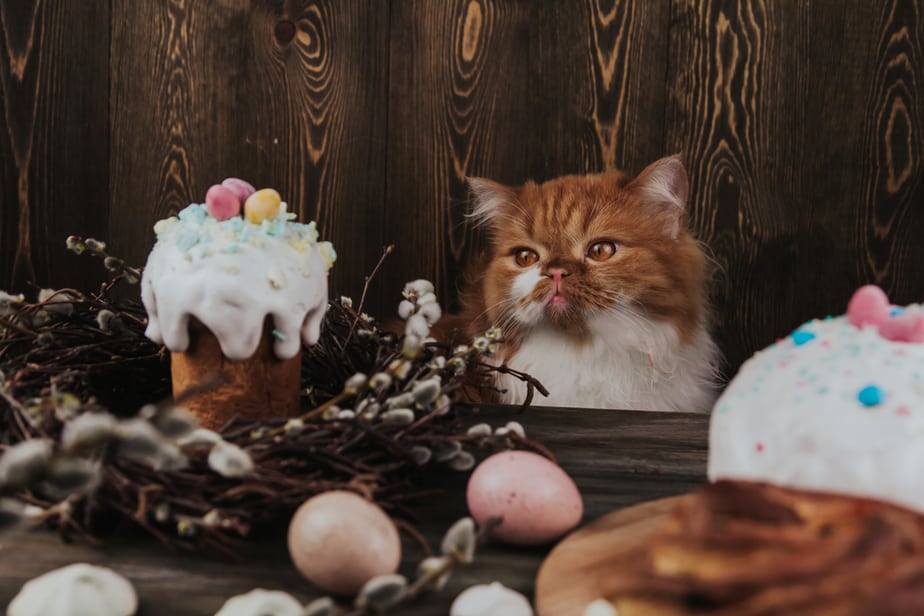
Whipped cream, as previously said, is high in fats. This is likely to pique your pet’s interest, as fat is necessary for their diet.
Fats in whipped cream, on the other hand, aren’t the healthiest, and your pet should stay away from them as much as possible. Natural fats in meat and some other fresh foods are an excellent source of energy for your cat.
They give her the energy she needs for everyday activities and keep her warm when her fur isn’t enough. Whipped cream, on the other hand, has a lot of saturated fats, which you don’t want to provide to your cat.
Saturated fats have been linked to the risk of heart disease and stroke because they raise harmful cholesterol levels in the blood. You should avoid butter if you want to maintain your cat healthy and fit.
Monounsaturated and polyunsaturated fats make up a very modest percentage of whipped cream’s total fat composition. These, as opposed to saturated ones, are known to have the opposite effect on your cat’s health.
It indicates that they are beneficial in reducing the risk of heart disease. However, the benefits of these healthy fats aren’t enough to compensate for the unfavorable effects of saturated fats.
Can cats eat puppuccino?
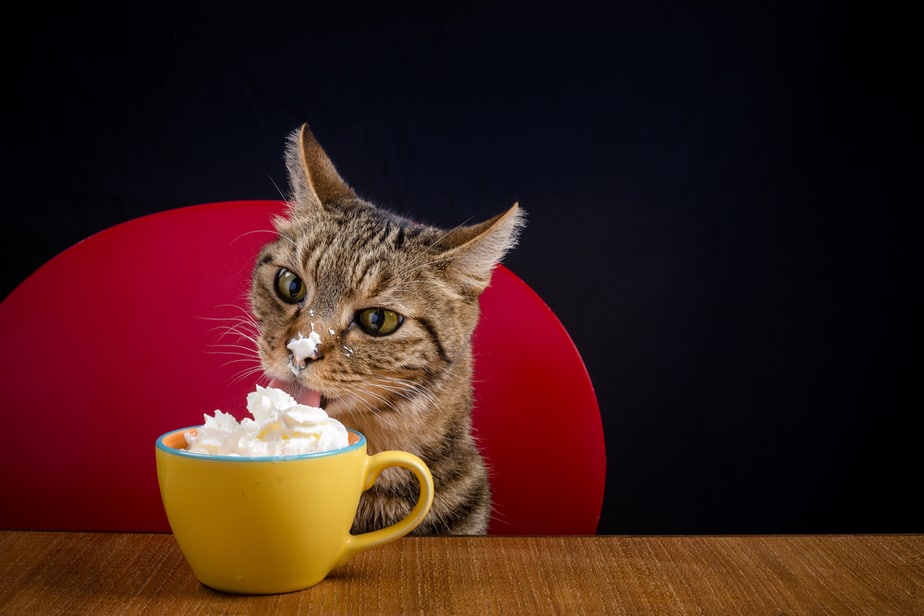
Our furry little friends have been our companions for many years now. Their unconditional love is met by our unbridled support, and the need to fulfill their wishes. You may even want to take it a step further and treat your pet with some Pupppuccino.
This treat is regarded as safe for pets, only if it’s given on rare occasions. Treating your cat to this delicacy every once in a while is fine, but don’t overdo it. Puppuccino is sweetened whipped cream in an espresso cup without caffeine.
However, it still contains dairy which can be harmful to your furkid in large portions. Make sure you don’t confuse your Starbucks drink for her because caffeine is poisonous to felines.
Caffeine elevates blood pressure and can trigger serious cardiac arrhythmias. Cats may also get tremors or seizures as a result, since caffeine affects their muscle control. It has an adverse effect on the gastrointestinal tract, causing vomiting and diarrhea.
Vomiting can help partially remove the toxin from her body, so it’s considered a beneficial side effect. However, caffeine poisoning in cats can be lethal, especially if no treatment is given.
Other dairy foods cats can’t have
Dairy foods are good for our health because they hold various beneficial nutrients. When you think of dairy, the first thought that comes to your mind is cow’s milk.
As kids, we were persuaded to drink milk because it would make our bones stronger. It is an important source of calcium and vitamin D, which promote bone growth and prevent fractures.
However, the same can’t be said about the impact dairy has on felines. Kittens indeed breastfeed just like any other baby mammal. However, after they grow out of the kitten stage, they lose the enzymes needed for breaking down lactose.
Lactose is a sugar found in milk that cats aren’t designed to digest. The lack of the enzyme lactase could lead your cat to experience gastrointestinal upset.
To prevent this from happening, try opting for some lactose-free milk. Still, when introducing it into your cat’s diet, watch out for any signs of a stomach upset.

1. Butter and margarine
We know butter is made of milk, but what else? Besides milk, it’s high in fats of which most are highly saturated. Next to fats, it contains a high amount of salt that could be detrimental to your pet’s health.
Cats can eat butter, but only for a few licks here and there. It’s a common ingredient in many dishes and difficult to avoid. It is also another reason why you shouldn’t encourage your pet to eat human foods.
It has no health benefits for cats and can even be harmful. The risks of salt poisoning and dairy allergies, as well as the high-fat content, simply aren’t worth it.
While margarine isn’t poisonous to cats, it does not meet any of their nutritional needs. Even though margarine isn’t dairy-based, it still isn’t ideal for cats. Furthermore, the high amounts of fat, carbs, and calories should deter you from feeding margarine to your pet.
A couple of licks won’t hurt, but keep her nutritional needs in mind. Excessive amounts, on the other hand, may cause stomach discomfort.
2. What about cheese? Is it safe for cats?
Cheese contains more fat than other dairy products. Cats require fat on a daily basis because it’s an important component of their diet. However, the type of fat found in cheese is not optimal for their needs.
Felines require unsaturated fat as a source of energy. Cheese, on the other hand, contains a lot of saturated fat, which is bad for your kitto.
While cheese puffs may look like a harmless snack, you should think twice. Too much cheese in any food can result in high cholesterol levels, which we all know results in weight gain and an increased risk of heart disease.
3. Can cats have sour and heavy cream?
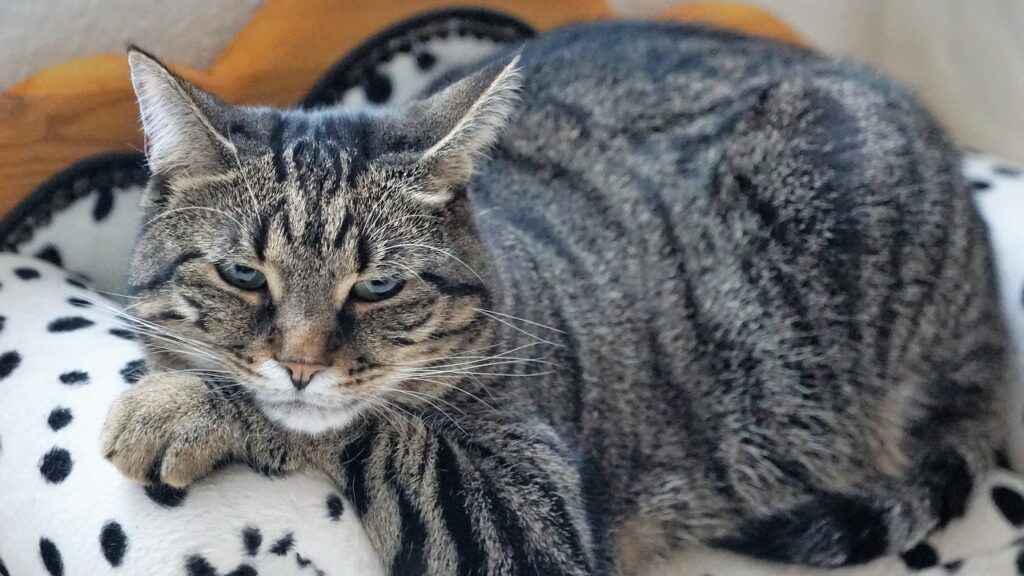
Sour cream is safe for cats to eat in small amounts. It contains vitamins and minerals that are beneficial to your pet’s health. It’s also high in protein, which cats require for survival.
There are, however, some drawbacks. Due to their lactose intolerance, cats eating sour cream can result in health complications. However, not all cats will have severe reactions.
If you want to give sour cream to your pet, choose lactose-free products or Greek yogurt. These contain less or no lactose, making them easier for your cat to digest.
Even if it is flavorless, in moderation, Greek yogurt is a tasty treat for your pet. It contains less lactose than sour cream, as well as less fat, and is lower in calories than regular yogurt.
Dairy allergy in cats
Unfortunately, dairy allergies are common in both people and felines. However, lactose intolerance is not the same as a dairy allergy. Lactose intolerance occurs in your cat’s digestive system, whereas dairy allergy is associated with your cat’s immune system.
They do share some symptoms. Diarrhea, bloating, and vomiting, for example, are symptoms of both lactose intolerance and an allergic reaction.
However, skin rashes, swelling of the mouth, and even respiratory problems will indicate if your cat has an allergy. All of these are reasons to panic and seek immediate veterinary assistance.
Is lactose-free/plant-based milk good for cats?
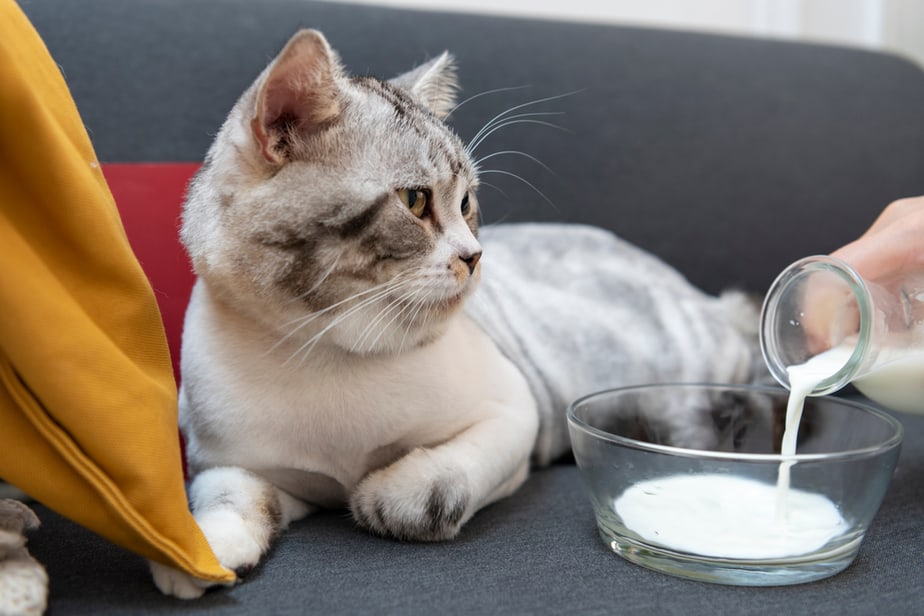
We all know that vegan food is made entirely of plant matter and contains no meat. Plants and carnivores are unlikely to get along. Surprisingly, almond milk is completely safe for cats, since it’s lactose-free.
Almond milk, which is high in vitamins and minerals, will help your cat’s immune system stay strong. Oat milk is generally considered safe for your cat to consume. However, she will not gain much in terms of nutrition.
Despite the fact that oat milk does not contain lactose, it may cause stomach upset in your cat, so keep an eye out for any signs of gastrointestinal distress.
Rice milk is high in calories and may cause weight gain as well as gastrointestinal discomfort in cats. The good news is that rice milk does not contain saturated fats, which are harmful to cats.
Coconut milk contains a lot of plant proteins, which are hard for a cat’s digestive tract to absorb. Small amounts of coconut milk as a treat are fine, but the high-fat content may cause digestive discomfort.
But be careful with confusing soy milk for soy sauce, for example. While soy sauce is highly risky for cats, soy milk is rather harmless. Talking about plant-based or vegan foods, tofu can be a great substitute for cheese!
To sum up, can cats eat whipped cream?
Can cats eat whipped cream in the end? Unfortunately, the answer is no. Whipped cream has negligible health benefits and nutritional value to cats.
It can be harmful to cats because of ingredients such as sugar, chocolate, vanilla, and others. These can be poisonous to felines and symptoms could range from mild to severe.
Other dairy products are poorly tolerated by cats’ bodies. Lactose could cause gastrointestinal distress in terms of vomiting, diarrhea, and bloating. Therefore, you should opt for some lactose-free or plant-based milk.
Introducing new foods in your furkid’s diet can be tricky as they’re already picky eaters, so make sure you do it slowly. However, plant-based foods are not a great option for carnivores like cats as they don’t provide them with crucial nutrients.
Puppuccinos can be a somewhat safer alternative to your furry buddy, but they should be offered only as an occasional treat. So, cats can eat whipped cream only if that means a lick or two once in a blue moon. Other than that, it’s a rollercoaster of bad luck!
Related post: Can Cats Eat Pancakes? Is It Good For Their Sake?

